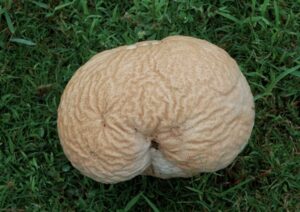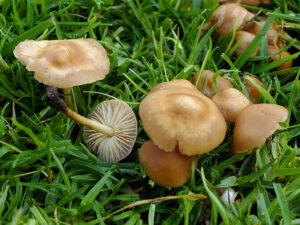Mushrooms, with their whimsical shapes and colors, add a touch of enchantment to forests and meadows. However, when they start popping up in your well-manicured lawn, they aren’t as magical.
If you’re wondering how to effectively eliminate mushrooms in your yard, read on. In this article, we’ll uncover the reasons behind their growth, whether they are harmful to your lawn, how to get rid of them and much more.
Why Do Mushrooms Grow in Lawns?
Mushrooms are the fruiting bodies of fungi that thrive in moist, organic-rich environments. Lawns that receive excessive moisture due to overwatering, poor drainage, or heavy rainfall create the perfect conditions for mushrooms to grow.
Additionally, the presence of decaying organic matter, such as tree roots or buried debris, acts as a food source for the fungi, encouraging their growth.
Looking for a way to replenish your lawn? Adding pallets of fresh sod will help fill in any bare spots in your lawn. Check out our sod installation service page for details.

Are Mushrooms Bad for a Lawn?
Contrary to popular belief, mushrooms themselves are not inherently bad for your lawn. In fact, they are beneficial. Mushrooms are bodies of fungi that play important roles in the ecosystem.
They aid in the decomposition of organic matter, breaking down dead plant material and recycling nutrients back into the soil.
Additionally, the mycelium network of fungi helps to create a symbiotic relationship with plant roots, enhancing their ability to absorb water and nutrients. So, while their presence may not align with the desired aesthetics of a well-manicured lawn, mushrooms actually indicate a healthy soil ecosystem in your yard.
In most cases, mushrooms are not harmful to a lawn. Mostly, mushrooms just disrupt the uniform appearance of your lawn and create an uneven surface, making it less enjoyable for activities such as walking or playing. The problem with mushrooms is that most of them are not edible, so make sure kids and dogs stay away.
Different Types of Mushrooms Found in Texas Lawns

Texas lawns are home to various types of mushrooms. A few common species include:
Puffballs (Calvatia spp.): These large, round mushrooms can reach sizes as large as a soccer ball. When mature, they release a cloud of spores when touched or disturbed.
Fairy Rings (Marasmius oreades): These mushrooms form circular or arc-shaped rings in the lawn. They are often accompanied by a noticeable dark green or dead patch of grass.
Stinkhorns (Phallus spp.): As the name suggests, these mushrooms emit a strong, foul odor. They have a characteristic phallic shape and attract flies for spore dispersal.
Inky Caps (Coprinus spp.): Inky caps are named for their tendency to liquefy and release black ink-like spore masses. They are typically found in lawns with thatch buildup or high organic matter.

Five Ways to Get Rid of Mushrooms
While it may not be possible to completely eradicate mushrooms from your lawn, the following methods will help control their growth:
Manual Removal: Wearing gloves, manually remove visible mushrooms by gently twisting and pulling them from the base. Dispose of them in a sealed bag to prevent spore dispersal.
Improve Drainage: Address any drainage issues in your yard by ensuring proper grading and adding amendments to improve soil structure. This will help minimize moisture accumulation, making it less favorable for mushroom growth.
Reduce Organic Matter: Remove any decaying tree roots, stumps, or other organic debris from your lawn. This will eliminate potential food sources for the fungi.
Increase Sunlight and Airflow: Trim back overhanging branches or thin out dense vegetation to allow more sunlight and airflow into your lawn. This will create drier conditions, discouraging mushroom growth.
Fungicide Application: If the mushroom infestation persists, you can opt for a fungicide specifically designed for lawn mushrooms. Follow the instructions carefully, and consider consulting a professional landscaper for appropriate product selection and application.
Once you get your lawn back in order, make your outdoor space stand out with the best landscaping services in Celina, TX.
Preventing Mushroom Growth in Your Lawn
Here are some preventative measures you can take to prevent mushrooms from proliferating in your lawn:
Proper Watering: Water deeply and infrequently to encourage healthy grass growth while minimizing excessive moisture. Avoid overwatering, as it creates a favorable environment for mushrooms to thrive.
Regular Lawn Maintenance: Keep your lawn well-maintained by regularly mowing at the correct height for your grass type and removing clippings, which can contribute to organic matter buildup. Say goodbye to mushrooms for good when you hire us for weekly lawn services.
Aerate and Dethatch: Periodically aerate your lawn to improve soil drainage and dethatch to reduce excessive organic matter accumulation. This will create an environment less conducive to mushroom growth.
Avoid Overfertilization: Excessive use of nitrogen-rich fertilizers can promote rapid grass growth and create conditions that favor mushrooms. Follow a recommended fertilization schedule and use balanced products.
Implement Proper Mulching: If using mulch in your landscaping, avoid placing it close to your lawn edges. Mushroom-friendly mulch, such as wood chips, can introduce fungi spores to your lawn.
Conclusion
While mushrooms in your yard may not be ideal, understanding their growth, utilizing appropriate removal techniques, and implementing preventative measures will help manage their presence effectively.
Remember, mushrooms can indicate underlying issues, so it’s essential to address any drainage, organic matter, or maintenance concerns to ensure the overall health and aesthetics of your lawn. With these strategies in place, you will enjoy a lush and mushroom-free yard year-round.
